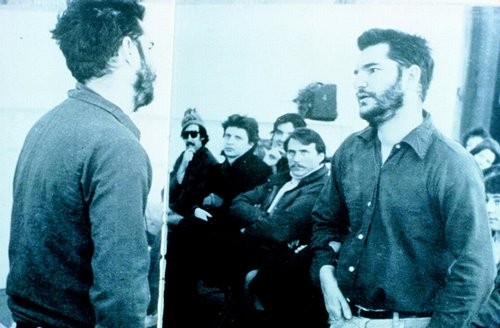Dan Graham
25 Jun - 11 Oct 2009

Dan Graham performing Performer/Audience/Mirror at P.S.1 Institute for Contemporary Art, Long Island City, NY, 1977, photo courtesy of the artist
DAN GRAHAM
"Beyond"
June 25-October 11, 2009
Dan Graham: Beyond surveys the artist's career from the mid-1960s to the present. As one of contemporary art's most innovative and influential figures, Dan Graham has been at the forefront of many of the most significant developments in art, including conceptual art, video and film installation, performance, site-specific sculpture, and musical collaboration. This exhibition—his first retrospective in the United States—examines each stage of Graham's career through his photographs, projects for magazine pages, films, architectural models and pavilions, performances, video installations, prints, drawings, writings, and his work with musicians Sonic Youth, Glenn Branca, and Japanther.
Graham was born in Urbana, Illinois, in 1942 and grew up in New Jersey, a suburban landscape that would inspire him throughout his career. He began his career as a writer, and founded and directed the short-lived John Daniels Gallery in New York in 1964, exhibiting the work of a new generation of conceptual and Minimalist artists—including Donald Judd, Sol LeWitt, and Robert Smithson. This experience had a deep influence on Graham's subsequent work, particularly the artist's relationship to his peers and to the culture at large as well as his interest in art’s economic and social framework.
Graham's rejection of the high-seriousness of modern art emerged at the same moment as Pop art in the early 1960s. "I love magazines because they are like pop songs," he once explained about his early conceptual magazine works, "easily disposable, dealing with momentary pleasures." He infused his approach with a wide range of literary, anthropological, and scientific influences, from cybernetics and topology to the writings of Jean-Paul Sartre, Gregory Bateson, and Margaret Mead. Graham's performances of the 1970s and his architectural pavilions of the 1980s to the present, with their kaleidoscopic refraction of bodily experience, demonstrate his interest in revealing the private self as part of a social, public context.
The fluid, democratic quality of Graham's work continues to exert a powerful influence on younger generations of artists. His desire for a connection to others mirrors our own; yet his work offers a way to critically explore that desire at a moment when interconnectivity and instant feedback are conditioning our collective consciousness to an unprecedented, global degree.
"Beyond"
June 25-October 11, 2009
Dan Graham: Beyond surveys the artist's career from the mid-1960s to the present. As one of contemporary art's most innovative and influential figures, Dan Graham has been at the forefront of many of the most significant developments in art, including conceptual art, video and film installation, performance, site-specific sculpture, and musical collaboration. This exhibition—his first retrospective in the United States—examines each stage of Graham's career through his photographs, projects for magazine pages, films, architectural models and pavilions, performances, video installations, prints, drawings, writings, and his work with musicians Sonic Youth, Glenn Branca, and Japanther.
Graham was born in Urbana, Illinois, in 1942 and grew up in New Jersey, a suburban landscape that would inspire him throughout his career. He began his career as a writer, and founded and directed the short-lived John Daniels Gallery in New York in 1964, exhibiting the work of a new generation of conceptual and Minimalist artists—including Donald Judd, Sol LeWitt, and Robert Smithson. This experience had a deep influence on Graham's subsequent work, particularly the artist's relationship to his peers and to the culture at large as well as his interest in art’s economic and social framework.
Graham's rejection of the high-seriousness of modern art emerged at the same moment as Pop art in the early 1960s. "I love magazines because they are like pop songs," he once explained about his early conceptual magazine works, "easily disposable, dealing with momentary pleasures." He infused his approach with a wide range of literary, anthropological, and scientific influences, from cybernetics and topology to the writings of Jean-Paul Sartre, Gregory Bateson, and Margaret Mead. Graham's performances of the 1970s and his architectural pavilions of the 1980s to the present, with their kaleidoscopic refraction of bodily experience, demonstrate his interest in revealing the private self as part of a social, public context.
The fluid, democratic quality of Graham's work continues to exert a powerful influence on younger generations of artists. His desire for a connection to others mirrors our own; yet his work offers a way to critically explore that desire at a moment when interconnectivity and instant feedback are conditioning our collective consciousness to an unprecedented, global degree.
